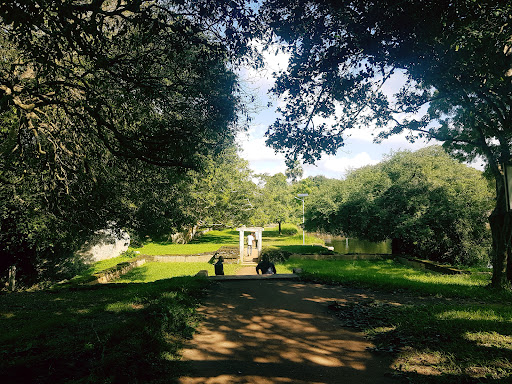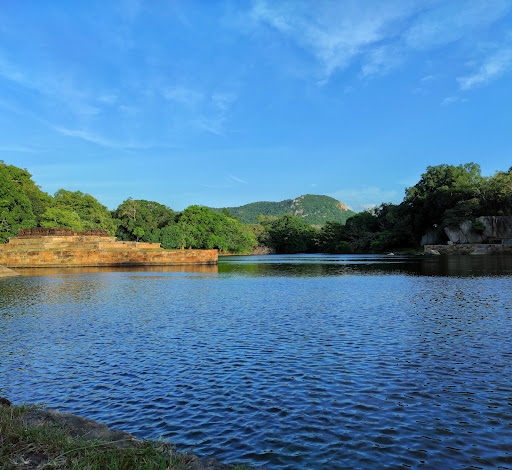Kaludiya Pokuna is also rich with numerous biodiversity, both flora and fauna. The forest is home for many endemic and non-endemic species of flora and fauna, that prevail much more secure than other forests in Sri Lanka.
Site is surrounded by farmland and human settlements from the north, east, and west but is undisturbed by humans and the primates are not provisioned. There is no evidence to indicate that hunting, timber extraction, or woodcutting have occurred at the site.
Forest is composed of many endemic and highly valuable trees and shrubs. The majority of flora are in the family Euphorbiaceae. Plants like Hydnocarpus venenata, Mischodon zeylanicus, Lepisanthes senegalensis, Grewia rothii, Ficus microcarpa, Mussaenda frondosa, Drypetes sepiaria, Mallotus eriocarpus, Manilkara hexandra, Dimocarpus longan, and Tetrameles nudiflora are abundant. Plants of family Ebenaceae, such as Diospyros ebenum, Diospyros malabarica, Diospyros oocarpa, and Diospyros ovalifolia, which has large timber value, are enormous without any human conflict.
Kaludiya Pokuna is rich with its populations of primate species mainly, where many researches on primates based on this site, especially on tufted gray langur and purple-faced langur. Besides them, forest is also home for the other primates in Sri Lanka, such as toque macaque and red slender loris and other herbivorous mammals, such as Asian elephants (Elephas maximus), spotted deer (Axis axis), sambar (Rusa unicolor), and wild boar (Sus scrofa). The area is also home to a full complement of potential predators such as black eagles (Ictinaetus malaiensis), crested serpent eagles (Spilornis cheela), brahminy kites (Haliastur indus), white-bellied sea eagles (Haliaeetus leucogaster), leopards (Panthera pardus), fishing cats (Prionailurus viverrinus) and Indian rock pythons (Python molurus).
Endemic snakes such as Sri Lanka flying snake, Boiga barnesii, Dendrelaphis bifrenalis, Dendrelaphis oliveri, Oligodon sublineatus are frequently seen. Venomous snakes like Indian cobra, Russell's viper and Hypnale hypnale. Numerous types of skinks and lizards...
Read moreKaludiya Pokuna is also rich with numerous biodiversity, both flora and fauna. The forest is home for many endemic and non-endemic species of flora and fauna, that prevail much more secure than other forests in Sri Lanka.
Site is surrounded by farmland and human settlements from the north, east, and west but is undisturbed by humans and the primates are not provisioned. There is no evidence to indicate that hunting, timber extraction, or woodcutting have occurred at the site.
Forest is composed of many endemic and highly valuable trees and shrubs. The majority of flora are in the family Euphorbiaceae. Plants like Hydnocarpus venenata, Mischodon zeylanicus, Lepisanthes senegalensis, Grewia rothii, Ficus microcarpa, Mussaenda frondosa, Drypetes sepiaria, Mallotus eriocarpus, Manilkara hexandra, Dimocarpus longan, and Tetrameles nudiflora are abundant. Plants of family Ebenaceae, such as Diospyros ebenum, Diospyros malabarica, Diospyros oocarpa, and Diospyros ovalifolia, which has large timber value, are enormous without any human conflict.
Kaludiya Pokuna is rich with its populations of primate species mainly, where many researches on primates based on this site, especially on tufted gray langur and purple-faced langur. Besides them, forest is also home for the other primates in Sri Lanka, such as toque macaque and red slender loris and other herbivorous mammals, such as Asian elephants (Elephas maximus), spotted deer (Axis axis), sambar (Rusa unicolor), and wild boar (Sus scrofa). The area is also home to a full complement of potential predators such as black eagles (Ictinaetus malaiensis), crested serpent eagles (Spilornis cheela), brahminy kites (Haliastur indus), white-bellied sea eagles (Haliaeetus leucogaster), leopards (Panthera pardus), fishing cats (Prionailurus viverrinus) and Indian rock pythons (Python molurus).
Endemic snakes such as Sri Lanka flying snake, Boiga barnesii, Dendrelaphis bifrenalis, Dendrelaphis oliveri, Oligodon sublineatus are frequently seen. Venomous snakes like Indian cobra, Russell's viper and Hypnale hypnale. Numerous types of skinks and lizards...
Read moreKaludiya Pokuna
Is also one of the famous ponds at Mihintale. The name is derived from the fact that the water in the pond appears to be black in colour. It is believed that on new moon day Kalu Buddha Rakkhita Thera sat under the Thimbiriya tree, close to the Kaludiya Pokuna, preached on sermon based on Kalakarama Sutta. The word "Kalu" means black. The word "diya" means water, and the word "pokuna" means pond.
Kalu Diya Pokuna – Natural Black Water Pond- Mihinthale – Sri Lanka
News & Updates
by Root Admin
මිහින්තලේ කලුදිය පොකුණ Situated at the foot of the western slopes of Mihintale it is the largest of the ponds. Most experts believe that Kaludiya pokuna may probably be the ancient Porodini Pokuna mentioned in the tablets of Mahinda IV.
Kalu-diya pokuna, literally translated means the black water pool. It is said that the name evolved out of respect to the sombre reflections of trees and boulders of the neighboring forests and mountains, and is true to its description at most times of the day.
The complex of well planned buildings around the pond is witness to an advanced hydraulic civilization with artificial moats running through some of the buildings; the bath houses, the toilets within the buildings.
Around the pond are the remains of an arama consisting of a stupa, uposathaghara or poya ge, the building where monks met at regular intervals to perform certain rituals pertaining to their conduct or behavior, cankamana patha, promenade for walking, parivena and pasada, residential cells janta ghara, bath house and vacca kutti lavatory.
A cave dwelling found in a slight depression in the vicinity is noteworthy. Tucked so cozily under a massive overhanging of a boulder, smooth granite slabs and brick are blended together to form the enclosing walls instead of the usual brick and mortar. Some scholars believe that this would have been a the bathing house attached to a bathing pokuna in front, now silted up.
Access to this place is possible from the Kandy main road, almost directly opposite the entrance to the Rajagiri...
Read more

